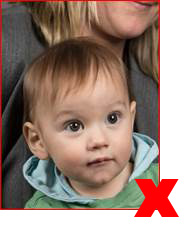A good passport photo is critical for a usable, secure passport.
Many countries, including Australia, use biometric technology to match your face against the image on your passport. Your photo needs to meet these guidelines so the biometric technology will work.
When you apply for a passport, you'll need to include 2 good-quality photos that meet all of the requirements on this page.
For a quick overview of these requirements, watch our video.

Who can take your passport photo
We recommend getting a professional passport photo provider to take your photos. You can find providers at:
- post offices
- professional photographers
- some large chain stores with printing facilities
- many camera stores
- some pharmacies and chemists
- other established reputable businesses.
We do not recommend using an online passport photo service or a mobile app. These may put you in danger of identity fraud.
Passport photo guidelines
Photo size
Your photos must be:
- 35–40 mm wide
- 45–50 mm high.
The height of your face, from your chin to your crown, must be 32–36 mm.
Photo quality
Your photos must be:
- less than 6 months old
- good quality colour prints, produced using dye sublimation (not from an inkjet printer).
They must have:
- a clear, in-focus image with no marks or red-eye
- a plain white or light background that contrasts with your face
- uniform lighting with appropriate brightness and contrast to show your natural skin tone
- your face centred and looking straight at the camera
- the edges of your face clearly visible.
They must not have:
- any retouching, such as removing moles, wrinkles or scars
- any shadows or reflections
- your head tilted in any direction
- your hair obscuring the edges of your face.
Anyone over 3 years old must have a neutral expression, eyes open, and mouth closed.
For children under 3 years old, their mouth may be open. But no one else can be visible in the photo.
Facial and head accessories
In general, you should have nothing on your face or head in your photo. But there are some exceptions.
Religious head coverings
If you usually cover your head for religious reasons, you can wear the covering in your passport photo.
Religious head coverings must be plain, without patterns (even small patterns).
You must wear them in a way that shows your entire face from the bottom of your chin to the top of your forehead. The edges of your face on either side must also be visible.
Jewellery and piercings
If you usually wear jewellery or have a piercing, you must ensure it doesn't obscure any part of your face. This is especially true around your eyes, mouth and nose.
There must also be no reflection from any rings or studs.
Glasses
You must not wear glasses in a passport photo unless you can't remove them for medical reasons. Vision impairment alone is not an acceptable reason to wear glasses in your photo.
If you can't remove your glasses for medical reasons, you must ensure:
- the frames don't obscure your eyes
- there's no reflection from your lenses.
Hearing aids
If you usually wear a hearing aid, you can wear it in your passport photo. This applies to adults, children and infants.
Acceptable and unacceptable photo examples
| Acceptable | Unacceptable | |
|---|---|---|

Acceptable |

Side on to camera |

Hair obscuring face |

Acceptable |

Insufficient contrast |

Background not plain |

Acceptable |

Background too dark |

Eyes/edges of face obscured |

Acceptable |

Eyes not open/toy visible |

Parent visible |

Acceptable |

No glasses |

Shadows on image and background |
Medical exemptions
If you can’t meet any of these photo guidelines because of a medical condition, you’ll need to either:
- provide a medical certificate
- complete a B-11 form that explains why.
Need help?
If you need help or advice about passport photos, contact us.